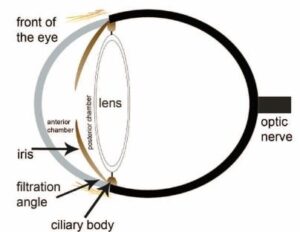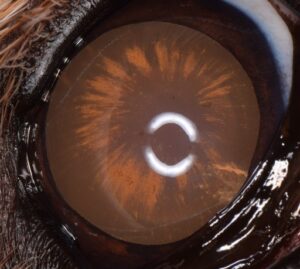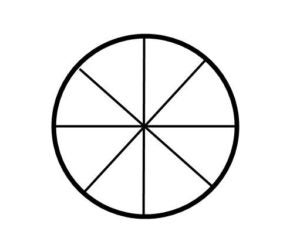
Golden Retriever Pigmentary Uveitis (GRPU) is an inflammatory disease of the eye recognized in Golden Retrievers throughout the United States and Canada.
It was first described in the scientific literature in 1996 and is now recognized as common in Golden Retrievers more than 8 years of age in the United States.
Despite ongoing research to understand the underlying genetics and disease mechanisms, many challenges remain for Golden Retriever owners and breeders trying to minimize the risks and damage caused by GRPU. The disease occurs equally in male and female dogs. It usually, but not always, affects both eyes.
The disease appears later in life, affecting dogs at an average age of 8.5 years. This late age of onset represents one of the major challenges of GRPU, since by the time of diagnosis, affected dogs may have already produced multiple offspring. While GRPU is a heritable disease, the pattern of inheritance and underlying genetic cause(s) remain unknown.
Another challenge presented by GRPU has been the perceived inconsistency in what examination findings warrant a positive diagnosis. Recently, current and former members of the American College of Veterinary Ophthalmologists’ (ACVO) Genetics Committee came together to create and publish clear diagnostic guidelines.
With funding from the AKC Canine Health Foundation, these updated diagnostic criteria for GRPU were recently published in the open source journal Veterinary Ophthalmology1 and are summarized here.

Diagnostic Criteria
Radial pigment (see Figure 2) on the front surface of the lens of the eye (the anterior lens capsule) is the hallmark of GRPU. The ACVO Genetics Committee recommends that “if radial pigment is present on the anterior lens capsule, the eye should be marked as affected by GRPU even if [additional clinical signs are not present].”


(For numerous photos depicting clinical signs of GRPU, see Townsend et al.)
It is also critical for examining ophthalmologists to take photos and make sketches of the examination findings to document progression of the disease in each patient and contribute accurate and detailed information for investigators studying this challenging disease.
Symptoms of Golden Retriever Pigmentary Uveitis
| Severity | Symptoms |
| Mild | · radial pigment on the front surface of the lens of the eye
+/- excessive pigment on the iris +/- increased protein in the anterior chamber +/- free floating pigmented cells in the anterior chamber +/- low intra-ocular pressure +/- red/irritated conjunctiva |
| Moderate | · radial pigment on the front surface of the lens of the eye
· varying amounts of excessive pigment on the iris +/- the iris may stick to the front surface of the lens of the eye +/- cataracts |
| Severe | · radial pigment on the front surface of the lens of the eye
· varying amounts of excessive pigment on the iris · fibrinous material in the anterior chamber · glaucoma |
Eye examination findings that do not warrant a diagnosis of GRPU include:
- pigment deposited on the iris and inner membrane of the cornea
- very dark iris coloration (particularly noted in light-coated Golden Retrievers)
- irregular pigment or a bluish haze at the lateral (toward the ears) edges of the cornea
If these traits are seen, the ophthalmologist should note the patient as “suspect GRPU but lacks radial pigment” and recommend follow-up examination.
Uveal cysts (fluid filled cysts on the iris, ciliary body or vascular lining of the eye) do not have to be visualized to make a diagnosis of GRPU. They have only been seen in 13% to 42% of eyes affected by GRPU. While uveal cysts have been noted as a risk factor, their role in the development and progression of GRPU is unknown.
Low intraocular pressure also does not need to be present to make a diagnosis of GRPU.
Treatment Options
Treatment of GRPU remains a challenge because the underlying disease mechanisms are not fully understood. Treatment with topical or systemic anti-inflammatory medications is the current standard of care. Additional medications to control glaucoma are added as needed.
Prognosis
The prognosis for dogs diagnosed with GRPU is guarded. The prevalence of glaucoma and vision loss in dogs secondary to GRPU has been reported as 21% to 45%. The presence of fibrinous material in the anterior chamber and adhesions of the iris to other structures are significant risk factors for the development of glaucoma. Annual eye examination by a board-certified ophthalmologist is recommended since early detection and treatment initiation appear to slow progression of the disease.
The Role of the ACVO Genetics Committee
The ACVO Genetics Committee consists of eight board-certified veterinary ophthalmologists, two advisors (one from the US and one from Europe), and an Orthopedic Foundation for Animals (OFA) liaison. The goal of this committee is to provide guidelines for eye disorders proven or suspected to be inherited or of major concern in purebred dogs.
The committee reviews scientific literature relevant to advances in canine ocular genetics and inherited ocular diseases to annually update the ACVO’s reference known as The Blue Book: Ocular Disorders Presumed to Be Inherited in Purebred Dog.
The committee’s OFA liaison also reviews all Companion Animal Eye Registry (CAER) forms submitted to the OFA for certification that have abnormal findings noted. Such forms are compared with previous examination forms from the same dog, reviewed, and discussed with the Genetics Committee before the final OFA rating is determined for that certificate.
More to Learn
The AKC Canine Health Foundation remains committed to collaborating with the Golden Retriever Club of America and the Golden Retriever Foundation (GRF) in the investigation of GRPU.
With funding contributed by GRF, CHF Grant 02569-MOU: Development of a Polygenic Risk Model for Pigmentary Uveitis in Golden Retrievers supports the study of multiple genes that appear to underlie GRPU.
In addition, CHF Grant 02590-A: Histologic characterization of Golden Retriever Pigmentary Uveitis is allowing investigators to examine an undefined, amorphous material found in the eye of Golden Retrievers with GRPU. Since this material is suspected to play a role in the development of secondary glaucoma, studying its composition, source, and prevalence in eyes affected by GRPU will provide valuable information to develop prevention and treatment strategies.
Summary
- Golden Retriever Pigmentary Uveitis (GRPU) is considered an inherited disease. However, the pattern of inheritance and underlying genetics remain unknown.
- Radial pigment on the anterior lens capsule is the definitive diagnostic criteria of GRPU. No other symptoms, such as uveal cysts or abnormal (low or high) intraocular pressure, are required for a diagnosis of GRPU.
- When an ophthalmologist makes a diagnosis of GRPU, the specific examination findings should be recorded and drawn in the comments section of the Companion Animal Eye Registry (CAER) form and submitted to the OFA to contribute to the scientific knowledge regarding GRPU.
Reference:
- Townsend, WM, Huey, JA, McCool, E, King, A, Diehl, KA. Golden retriever pigmentary uveitis: Challenges of diagnosis and treatment. Vet Ophthalmol. 2020; 00: 1– 11. https://doi.org/10.1111/vop.12796

